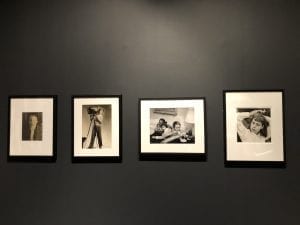Today was art museums galore! We started the day at the Smithsonian American Art Museum, had a little lunch break, then headed to the National Museum of Women in the Arts (NMWA), which I will be discussing a bit further in this post. Quick thanks to Ashley Harris, NMWA’s Associate Educator, for coordinating our visit to NMWA!
First, a brief history on the NMWA. Put simply, the museum was founded under the following guiding question: where are all the woman artists? According to our tour guide as well as the museum’s website, the museum recently celebrated its 30th anniversary and showcases art by female artists. The museum’s founding is directly linked to a female art collector named Wilhelmina Cole Holladay, who, in the 1960’s, noticed a lack of representation of female artists. Over the next 20 years, she dedicated her time and resources to founding an art museum that would further celebrate and recognize female artists, ultimately resulting in the NMWA.
Our visit consisted of a tour of the museum, followed by a discussion with a volunteer in their library and a museum employee. During our tour, we saw a ton of wonderful art by female artists including Elisabeth Vigee le Brun, Lois Mailou Jones, Cindy Sherman, and Frida Kahlo. My personal favorite was Judy Chicago’s extraordinary exhibit titled “The End: A Meditation on Death and Extinction.” It contained three different rooms: depictions of the five stages of grief, a set of pieces wondering how she will die, and then a room filled with images of dying species due to human actions (or, inaction). I would include photos of this exhibit, but it was the one exhibit we could not photograph.
Our tour guide was full of great anecdotes about Mrs. Holladay and was very informative about all the pieces we saw. My personal favorite quote from our guide was from the beginning of our tour when she was discussing the multiple uses of the building. She informed us that the building not only holds the artwork, but is rented out for various events, including weddings. Our guide then said, “If you have to ask how much it costs to rent, it’s not for you,” a comment that received an abundance of laughs from our group.
Full disclaimer: I walked into the NMWA with a specific expectation that was somewhat debunked by the end of our visit. As a museum featuring female artists, I expected the museum to be full of images that reclaimed the female body and femininity. I fully expected the museum to be infused with feminist images and have Beyonce’s “Who Run the World (Girls)” song playing throughout the building. Actually, Beyonce’s song and accompanying music video is a good way to picture how my mind imagined the NMWA before our visit.
Sometimes, my expectation was fulfilled. Some images I saw did seem to reclaim femininity and the female body, embracing the female body and unapologetically depicting the power of women and what it means to be a woman in America. But the majority of the time, I was incredibly wrong in my expectation. In reality, this museum features a wide spectrum of art and, again, while some seems to have a feminist backing, others are simply pieces by women artists.
While at the museum, I was thinking about how democracy can be seen in this museum and I ended up primarily considering how art (among many, many other reasons) can either created as a political response or can be created from a political event. Or in some cases, both. For example, Judy Chicago’s exhibit featuring animal extinction, to me, was a response to how the political world has ignored climate change and animal rights to the extent that it is causing extinction. It seemed as though she was responding to the political world in the way she knew best – art.
However, we also saw photographs that were funding by the Works Progress Administration (WPA) – in other words, funded by the government. The government found art to be important enough to include in the WPA, and therefore these photographs were created from a political event. In my opinion, the photographs didn’t seem to portray any specific political message, but rather depicted life in the time of the WPA. Here are the WPA-funded photographs we saw:

Speaking of relationships with the government, as a non-profit organization, the NMWA has a unique relationship with the government. I think it was particularly interesting to contrast the Smithsonian American Art Museum to the NMWA in terms of government funding. Basically, we learned that the NMWA is primarily funded by admissions fees, private donations, corporate donations, and memberships. However, it does also receive some overarching government funding and they often apply for specific funds. In contrast, the Smithsonian American Art Museum is fully funded by the government.
Because of the differences in funding, the Smithsonian is free, while the NMWA has an admissions price. Because of this discrepancy, I want to end this blog post discussing privilege in relation to art and museum viewing. Paying for admission to a museum or a full membership requires an element of privilege, and because of the Smithsonian’s free admission, it is going to be more accessible to a broader population. The basic reality is that museums need funding; if it is not funded by the government, it needs funding somehow. However, that makes me consider my final question: should more museums around the country be funded by the government to increase art accessibility?
Works Cited:
Beyonce. “Beyonce – Run the World (Girls) (Video – Main Version).” YouTube, 18 May, 2011. https://www.youtube.com/watch?v=VBmMU_iwe6U.
“Our History.” National Museum of Women in the Arts. https://nmwa.org/about/our-history. (retrieved 8 January, 2020).
